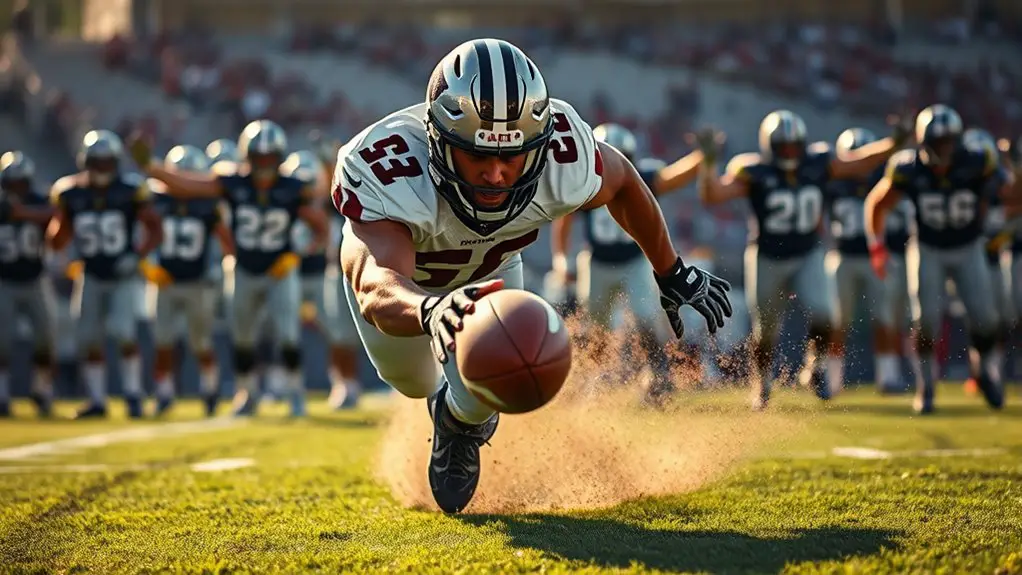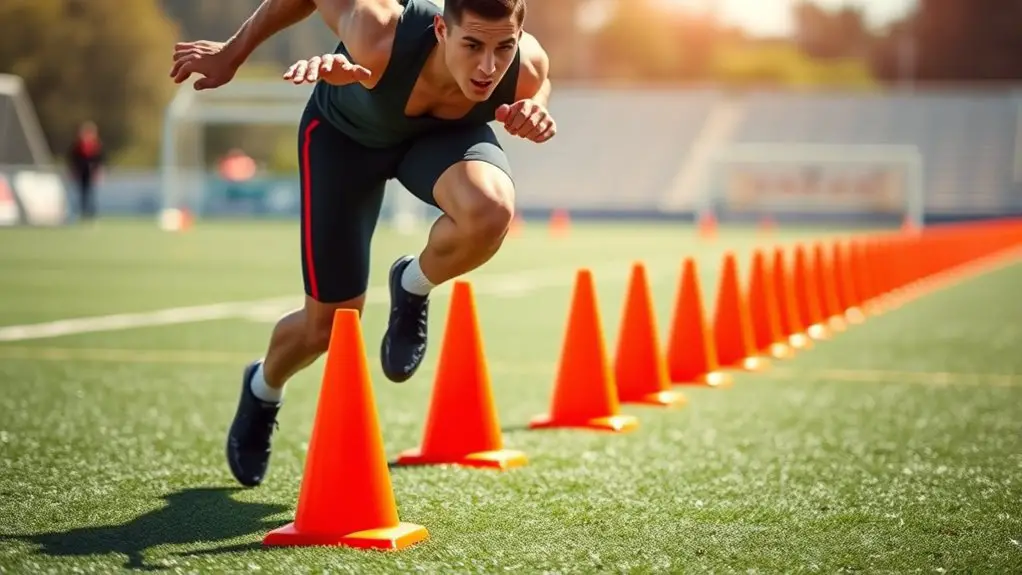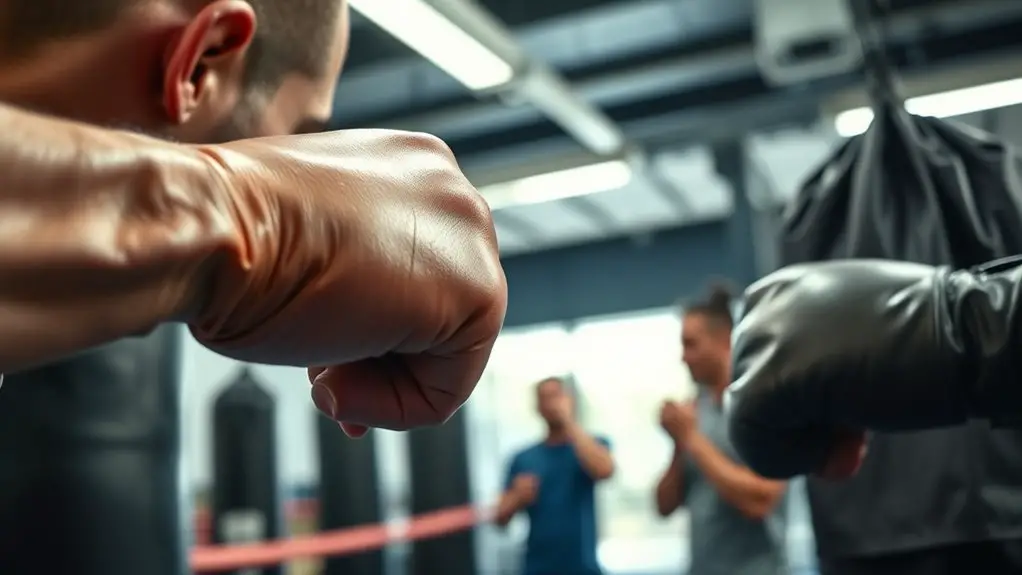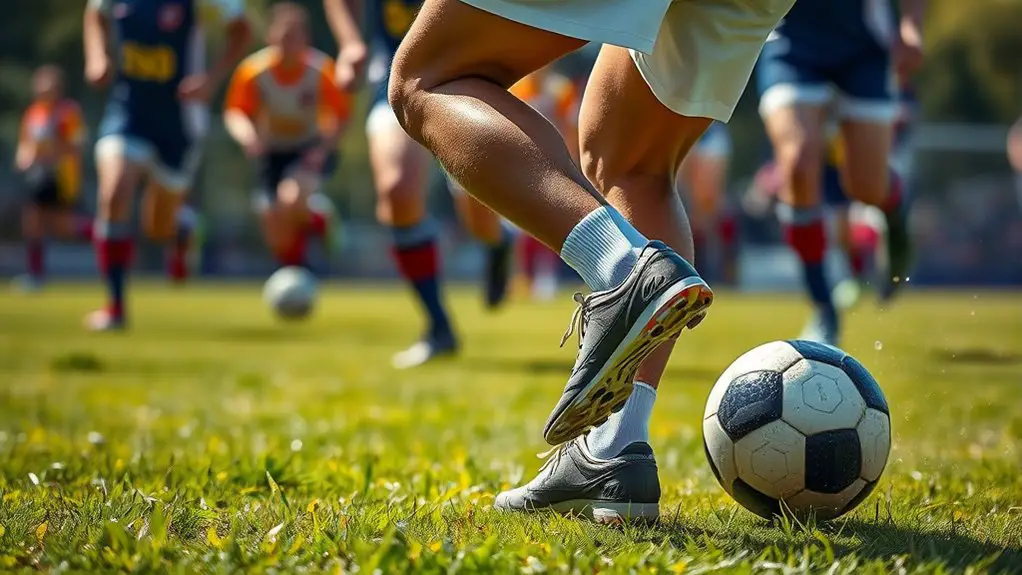The biomechanics of a perfect kickoff return involve mastering speed, agility, and body positioning as you sprint down the field. You need to anticipate the trajectory of the kick and maintain a low center of gravity for balance. Quick footwork and decisive cuts help you navigate around defenders, while strong core stability supports control. Vision and awareness play critical roles in identifying gaps and making split-second decisions. There's much more to uncover about optimizing your return skills.
Understanding the Kickoff Return Process
When you watch a kickoff return, you might not realize the intricate mechanics at play. The kickoff technique is vital; it involves more than just catching the ball. You need to anticipate the trajectory and position yourself to maximize your momentum. Your body's alignment and footwork are key in setting up an effective return strategy.
As you receive the kick, your first moves should be planned—where are the blockers? Which lanes are open? It's all about reading the field quickly and decisively. You've got to trust your instincts while also adhering to the team's tactics.
The balance between individual flair and team coordination is fundamental. While freedom of movement is important, you're part of a cohesive unit working together to capitalize on every opportunity. Each return is a dance of strategy, skill, and split-second decisions that can lead to exhilarating moments on the field. Mastering proper footwork is essential to reduce the risk of injuries and enhance overall performance during the return.
The Role of Speed and Acceleration
Speed and acceleration are essential components of a successful kickoff return. When you break free from the pack, your ability to accelerate can turn a good return into a great one. Engaging in speed training not only enhances your quickness but also builds the explosive power needed to evade defenders. Acceleration drills, like cone sprints and hill runs, can sharpen your starts, giving you that critical edge in the first few steps.
You've got to embrace the freedom of movement and let your instincts guide you. The more you practice these drills, the more you'll fine-tune your body's mechanics, allowing for a seamless shift from receiving the ball to sprinting downfield. Remember, it's about harnessing your natural speed and making it work for you. Additionally, incorporating strength training exercises into your routine can further enhance your explosive movements. So get out there, push your limits, and feel the rush of the open field as you aim for that end zone!
Optimal Body Positioning
To maximize your effectiveness on a kickoff return, focusing on your body positioning is key. You'll want to maintain a low center of gravity, adjust your knee bend angle, and utilize proper arm swing mechanics. These elements work together to enhance balance and power as you navigate the field. Additionally, a strong core is essential for enhanced stability and control during dynamic movements, allowing for more effective navigation through opposing players.
Center of Gravity
The center of gravity plays an essential role in achieving ideal body positioning during a kickoff return. By understanding how to manipulate your weight distribution, you can enhance your balance techniques, allowing for greater agility and speed. Here's how to optimize your center of gravity for that perfect return:
- Keep your knees slightly bent for stability.
- Position your feet shoulder-width apart for a strong base.
- Lean slightly forward to maintain momentum.
- Engage your core to support quick directional changes.
- Use your arms for balance and to propel yourself forward.
Mastering these elements will help you harness your body's natural mechanics, letting you flow freely and navigate the field with confidence.
Knee Bend Angle
While executing a kickoff return, finding the right knee bend angle is essential for ideal body positioning. The proper knee flexion mechanics allow you to lower your center of gravity, enhancing stability and agility. When you flex your knees at the best angle, you can absorb impact forces more effectively, reducing the risk of injury. This precise positioning creates a powerful spring effect, enabling you to explode forward when it's time to accelerate. Impact force analysis shows that a well-bent knee not only helps in absorbing shock but also maximizes your energy transfer during the sprint. Embracing this freedom of movement, you'll find yourself maneuvering through defenders with finesse and confidence, making every return an exhilarating experience.
Arm Swing Mechanics
Generating momentum through effective arm swing mechanics plays an essential role in optimizing your body position during a kickoff return. By mastering the art of arm coordination and maintaining a consistent swing rhythm, you'll enhance your overall performance. Here are key elements to evaluate:
- Keep your elbows bent at around 90 degrees for efficient movement.
- Swing your arms back and forth in sync with your legs for balance.
- Use your shoulders to drive the motion, generating more power.
- Focus on a smooth, fluid motion to avoid wasting energy.
- Maintain a relaxed grip to prevent tension, helping your body flow freely.
Embrace these mechanics, and you'll feel empowered as you navigate the field with speed and agility.
Footwork and Agility Techniques
Mastering footwork and agility techniques is essential for a successful kickoff return, as these skills can mean the difference between a modest gain and a game-changing play. Your foot placement is vital; it sets the foundation for your movements. By keeping your feet shoulder-width apart, you'll maintain balance while being ready to explode in any direction.
Focus on lateral movement to evade defenders. Quick, side-to-side steps allow you to create space and find the best path. Practice drills that enhance your agility, like ladder drills or cone exercises, to sharpen your reflexes and speed. Remember, it's not just about moving fast; it's about moving smart. Being unpredictable in your footwork can leave defenders grasping at air, giving you the freedom to navigate through traffic. Incorporating agility ladder drills into your training routine will help build your foundational agility and coordination. Embrace these techniques, and you'll elevate your kickoff return game to new heights.
Timing: The Key to Success
Timing is essential for a successful kickoff return. You need to anticipate the kick and synchronize your movements to maximize your speed and agility. Get it right, and you'll find yourself in a great position to make a big play. Incorporating interval training into your routine can enhance your explosive speed, giving you an edge on the field.
Anticipating the Kick
Anticipating the kick is essential for a successful return, and getting the timing right can make all the difference. Mastering kick anticipation involves more than just physical skills; it requires mental preparation to read the game. Here's how you can fine-tune your senses:
- Pay attention to the kicker's stance and body language.
- Visualize the trajectory of the ball as it leaves the foot.
- Stay relaxed but alert, ready to react in an instant.
- Trust your instincts and practice recognizing patterns.
- Focus on the sound of the ball being kicked for auditory cues.
Synchronizing Movements Effectively
To achieve a successful kickoff return, it's essential that you synchronize your movements with the unfolding play. This means mastering movement coordination, ensuring your body responds fluidly to your surroundings. As the ball is kicked, focus on muscle synchronization—your legs and arms should move in unison to propel you forward while maintaining balance.
You'll want to feel the rhythm of the game; every step should be intentional, responding to the defenders' positions. Timing is everything; a split-second delay can throw off your entire return. Trust your instincts, and let your body flow with the momentum. When you connect your movements seamlessly, you not only enhance your performance but also release the freedom to navigate through the chaos of the field.
Navigating Through Defenders
Five key strategies can help you navigate through defenders during a kickoff return. Mastering these techniques enhances your defender evasion and boosts your chances of breaking free. Your spatial awareness is essential, allowing you to read the field and react quickly.
- Quick Cuts: Shift your weight and change direction rapidly to throw off defenders.
- Decisive Acceleration: Burst forward when a gap opens, catching defenders off guard.
- Body Fakes: Use head and shoulder movements to mislead opponents about your next move.
- Maintain Balance: Stay low and centered to absorb contact without losing speed.
- Anticipate Moves: Read defenders' body language; predict their actions to adjust your path effectively.
Incorporating agility training techniques can further enhance your ability to evade defenders and improve your overall performance on the field.
The Importance of Vision and Awareness
Vision and awareness are essential for a successful kickoff return. You need to be fully engaged, tapping into your situational awareness to anticipate what's ahead. It's not just about speed; it's about how well you can read the field and the defenders. When you're sprinting down the field, visual scanning becomes your best ally. This means constantly checking where your teammates are, identifying gaps, and spotting potential threats.
The moment you catch the ball, your eyes should already be working to map out the best route. You've got to see the big picture while focusing on the details—who's coming at you, where your blockers are, and the open lanes. This awareness allows you to make split-second decisions that can turn a good return into a great one. Incorporating mental conditioning techniques can further enhance your ability to react quickly and effectively. So, sharpen your vision and trust your instincts; freedom on the field comes from being aware of every move you make.
Strength and Conditioning for Kickoff Returners
While speed and agility are essential for kickoff returners, strength and conditioning play an equally important role in maximizing performance on the field. You need a solid foundation to burst through tackles and maintain balance while maneuvering through the chaos of a return. Here's what you should focus on:
- Strength training: Build explosive power with weightlifting and resistance exercises.
- Plyometrics: Enhance your quickness and agility through jump training.
- Endurance: Incorporate conditioning programs that boost stamina for longer runs.
- Core stability: Strengthen your core for better balance and support during evasive maneuvers.
- Flexibility: Improve your range of motion to prevent injuries and enhance overall performance. Incorporating squats and lunges into your routine can significantly improve lower body strength and stability.
Analyzing Successful Kickoff Returns in History
Successful kickoff returns throughout history showcase not only individual talent but also the impact of effective strength and conditioning. A historical analysis reveals that the greatest returns come from athletes who blend speed, agility, and strategic vision. You can't help but feel the exhilaration as you watch these remarkable plays unfold, fueled by innovative return strategies. In these instances, the athletes often utilize explosive movements to maximize their performance.
Here's a breakdown of some iconic returns:
| Year | Player | Return Yardage |
|---|---|---|
| 2006 | Devin Hester | 108 |
| 2010 | Jacoby Jones | 108 |
| 1994 | Desmond Howard | 99 |
| 1986 | Walter Payton | 95 |
| 1978 | Billy "White Shoes" Johnson | 95 |
These moments remind you of the freedom and excitement that comes from a perfectly executed return, emphasizing the blend of athletic prowess and tactical genius that defines the game.
Frequently Asked Questions
What Equipment Is Essential for a Successful Kickoff Return?
When you think of a successful kickoff return, it's like a dance with the field—every move counts. To shine in this performance, you need the right return gear, including a reliable helmet, shoulder pads, and cleats for grip. Don't forget your protective equipment, like mouthguards and thigh pads, to keep you safe while you're weaving through defenders. Embrace the freedom of the game, and gear up for your moment to shine!
How Does Weather Impact Kickoff Return Performance?
Weather can greatly impact your kickoff return performance. Wind resistance can alter your speed and direction, making it harder to maintain balance and control. If it's rainy or snowy, field conditions can become slippery, increasing the risk of falls and reducing your traction. You'll need to adjust your techniques and strategies based on these factors. Embracing these challenges can lead to a more exhilarating and freeing experience on the field.
What Mental Strategies Aid Kickoff Return Success?
To enhance your kickoff return success, consider using visualization techniques. Picture yourself maneuvering the field, dodging defenders, and scoring a touchdown. This mental imagery can boost your confidence and performance. Pair this with focus strategies, like breathing exercises or setting specific goals for each return. By honing these skills, you'll feel more in control and free to make split-second decisions, ultimately elevating your game and maximizing your potential on the field.
How Can Injuries Affect a Kickoff Returner's Performance?
Injuries can turn a promising kickoff returner's performance into a shadow of its former glory. You've got to focus on injury prevention and recovery techniques, or those setbacks could haunt you. Staying fit and agile is essential, as a single tweak can derail your entire season. Remember, mastering your body isn't just about speed; it's about resilience. Embrace freedom by prioritizing your health, so you can return to the field stronger than ever.
What Role Does Teamwork Play in Kickoff Returns?
Teamwork's essential in kickoff returns. You've got to rely on your teammates' communication strategies to guarantee everyone's on the same page. Effective player positioning can make or break the play. If you and your teammates understand your roles and execute them well, you'll create openings and increase the chances of a successful return. Remember, it's about trusting each other and working together to achieve that freedom on the field.




